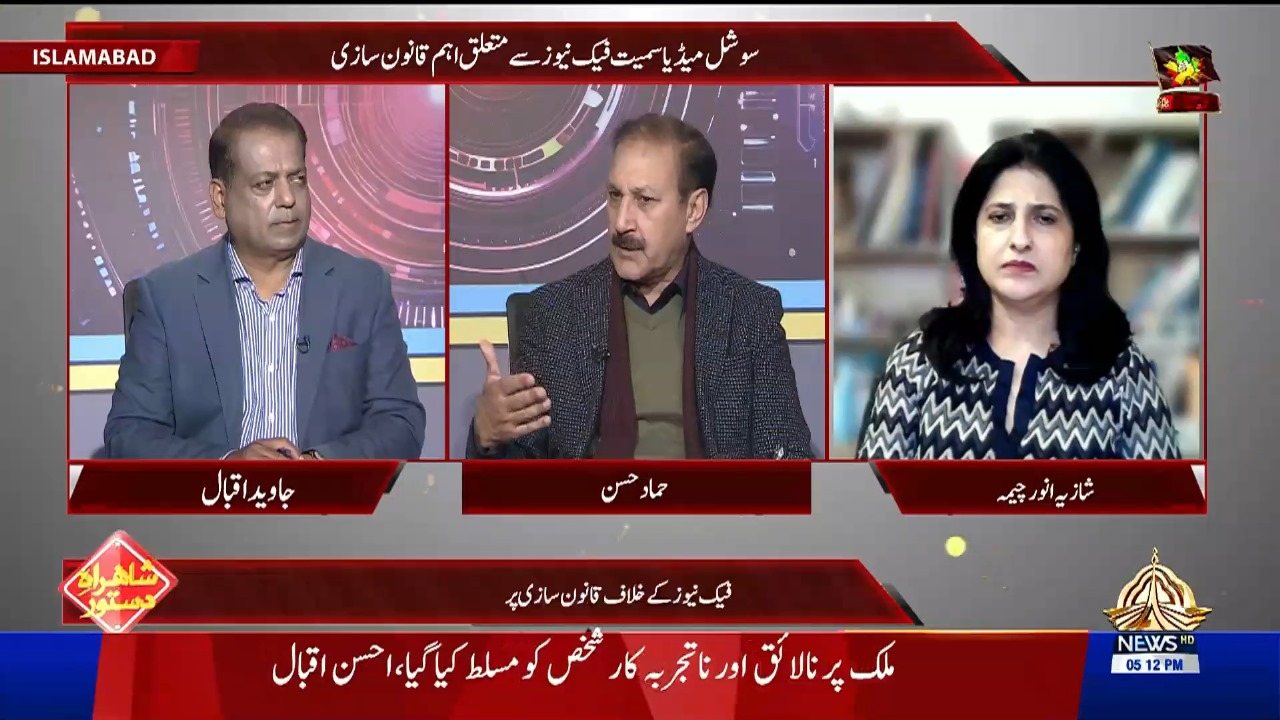Monitoring Desk: “This is the foremost obligation of responsible journalism to protect the facts and follow media ethics and if the media is following ethical journalism then it should not be worried about laws that are introduced to mitigate yellow journalism and fake news”.
These were observations of participants in a PTV talk show “SHAHRAH E DASTOOR” anchored by seasoned journalist Javed Iqbal and participated by senior analyst and journalist Hammad Hassan and foreign affairs expert and media academician Shazia Anwer Cheema on Sunday.
The discussion evolved around fake news, media ethics, and laws the government has introduced for controlling digital terrorism in the country, participants explained that the phenomenon of Fake News is linked with the post-Truth Era and social media are some of the leading sources for spreading disinformation, hate, chaos, deep fake, cheap fake, and almost every kind of genre of untrue news. These platforms practically allow social miscreants to hide their real identities and use fake identities to spread hate and chaos among users and Pakistan facing the onslaught of anti-Pakistan campaigns that are catchy in graphics and content and provide verificatory news engagement opportunities to the consumer in order to further elaborate and spread it. Anti-state elements always use verificatory news because it provides a margin for extensive anti-subject debate and does not bear the burden of verifiability. They create filter bubbles and echo chambers that are based on the idea of the post-truth era. The concept of post-truth has been on the Western agenda and has been used for creating color revolutions in Eastern Europe as well as in the Middle East and the same has been used against Pakistan as a kind of digital terrorism.

The post-truth era when appearance substituted being and the old-fashioned character-building became redundant mainly because old norms were heavily discarded and the rhetoric of “my truth and your truth” replaced the universal truths.
Pakistan was affected by this infodemic precisely when Imran Khan came in mainstream politics by negating all conventional norms. He skillfully replaced his being with his appearance, like actants switching personal conduct according to populist belief and demand.

Participants were of the view that a layman usually gets confused between fake and false news. False is untrue and fake is when reality undergoes a treatment plan. In the fake news, senders instead of presenting the reality to the Receiver, want to reshape this reality according to their ideology/requirements and then present it to the Receiver. This process depends upon two things; a grain of truth and exploitation of emotions. The construction/reshaping of reality can be through beliefs or emotions. In such ways, the recipient is tried to be persuaded, and thus behavioral change is achieved. And today we are witnessing the aftermath in the form of behavioral change of a fraction of affected victims.
During this catastrophic campaign of fake news against Pakistan, all the textbook experimentation of propaganda is being executed creating an echo chamber of anti-subject. The actual issue and event have always been presented by putting the anti-subject in the foreground. Whatever the news is they always present it with a slant always tilted toward the anti-Pakistan stance. The idea that the anti-subject does not know the truth that we know and believe and is trying to destroy it is the main theme of post-truth discourse. Participants explained that it is not the transmission of the truth but the persuasion of presenting real or fake news in an orderly manner and in certain cases the mainstream media in Pakistan is also involved in this practice. They said that fake news is believable and the public, who is the recipient of the information that is told by transforming the truth into fiction in the form of a narrative, will experience a dilemma between reality and post-truth information.
So what fake news does is create an alternative reality because available truth is not generally accepted. This concept indicates a reorganization of that reality in cases where generally accepted objective facts are less influential in shaping public opinion than public appeals. In other words, “false reality” presented to the Receiver emerges next to the actual reality. The post-truth refers to situations where objective facts are less influential in shaping public opinion than appealing to emotions and personal views. In other words, the verifiable perception of reality in the post-truth era will be a secondary factor in the formation of meaning, which is described by sensations, emotions, and passions.
They were of the view that it is the foremost duty of the state to take action against those who promote post-truth and laws must be followed by practitioners (journalists-media persons) and they must avoid manipulating emotional impulses on the other. In the emotional sense, perhaps the person does not want to know the truth as it is but wants to hear and know it in a way that pleases him. Mostly, the Sender creates a virtual identity in society as a morally pure, clean, sincere identity against the corrupt side of the social system.
Participants were of the opinion that anti-Pakistan elements have been investing a huge amount in spreading fake news and at the receiving end, a layman who can’t even differentiate ‘fake news’ from ‘false news’ consumes a well-crafted fake message as a reality. They were of the view that The state must play its role in protecting consumers from yellow journalism, fake news, and false narrative building that are harming Pakistan.
